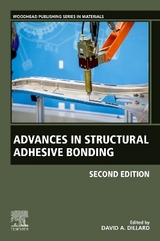
Advances in Structural Adhesive Bonding
Woodhead Publishing Ltd (Verlag)
978-1-84569-435-7 (ISBN)
- Titel erscheint in neuer Auflage
- Artikel merken
Adhesive bonding is often effective, efficient, and often necessary way to join mechanical structures. This important book reviews the most recent improvements in adhesive bonding and their wide-ranging potential in structural engineering.Part one reviews advances in the most commonly used groups of structural adhesives with chapters covering topics such as epoxy, polyurethane, silicone, cyanoacrylate, and acrylic adhesives. The second set of chapters covers the various types of adherends and pre-treatment methods for a range of structural materials such as metals, composites and plastics. Chapters in Part three analyse methods and techniques with topics on joint design, life prediction, fracture mechanics and testing. The final group of chapters gives useful and practical insights into the problems and solutions of adhesive bonding in a variety of hostile environments such as chemical, wet and extreme temperatures.With its distinguished editor and international team of contributors, Advances in structural adhesive bonding is a standard reference for structural and chemical engineers in industry and the academic sector.
David A. Dillard is Adhesive and Sealant Science Professor, in the Biomedical Engineering and Mechanics Department at Virginia Polytechnic Institute and State University, USA. He has worked extensively in the field of adhesive bonding, having experience in structural adhesives for aerospace, automotive, and infrastructure applications, adhesives and coatings for microelectronic applications, pressure sensitive adhesives, elastomeric adhesives and sealants, and polymeric membranes. Prof. Dillard has authored or co-authored over 185-refereed publications and regularly teaches courses in adhesion science, polymer viscoelasticity, and sustainable energy solutions. His research involves developing test methods and predictive models for understanding and estimating the performance and durability of polymeric materials, adhesives and bonded joints, using the principles of fracture mechanics and viscoelasticity. Over the past several years, he has become active in applying these concepts to sustainable energy products including proton exchange membrane fuel cells and solar photovoltaic applications. Prof. Dillard has received several awards in recognition of his research.
Part 1 Adhesive selection: Key issues in selecting the right adhesive; Advances in epoxy adhesives; Advances in polyurethane structural adhesives; Advances in structural silicone adhesives; Advances in cyanoacrylate and anaerobic adhesives; Advances in acrylic structural adhesives; Advances in nanoparticle reinforcement in structural adhesives. Part 2 Adherends, surfaces and pre-treatments: Improvements in bonding metals (steel, aluminium); Advances in bonding plastics; Advances in bonding composites. Part 3 Joint design: Selecting the right joint design and fabrication techniques; Life prediction for bonded joints in composite material based on actual fatigue damage; Improving adhesive joint design using fracture mechanics; Developments in testing adhesive joints; Advances in testing adhesively-bonded composites. Part 4 Environmental effects and durability of adhesives: Designing adhesive joints for fatigue and creep load conditions; Improving bonding in high and low temperatures; Assessing and improving bonding in wet conditions; Improving bonding in hostile chemical environments.
| Erscheint lt. Verlag | 31.3.2010 |
|---|---|
| Reihe/Serie | Woodhead Publishing Series in Welding and Other Joining Technologies |
| Verlagsort | Cambridge |
| Sprache | englisch |
| Maße | 156 x 234 mm |
| Gewicht | 1110 g |
| Themenwelt | Naturwissenschaften ► Chemie ► Technische Chemie |
| Technik ► Bauwesen | |
| Technik ► Maschinenbau | |
| ISBN-10 | 1-84569-435-X / 184569435X |
| ISBN-13 | 978-1-84569-435-7 / 9781845694357 |
| Zustand | Neuware |
| Informationen gemäß Produktsicherheitsverordnung (GPSR) | |
| Haben Sie eine Frage zum Produkt? |
aus dem Bereich



